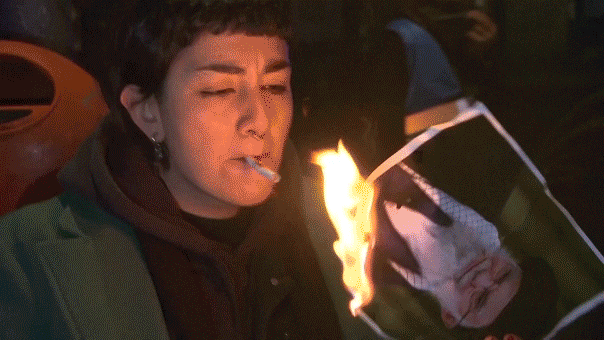
Commuters wait at a bus stop as rain brought by the outer bands of Tropical Storm Sandy falls in Kingston, Jamaica, Tuesday, Oct. 23, 2012. The U.S. National Hurricane Center in Miami said Sandy was expected to become a hurricane as it nears Jamaica on Wednesday. (AP Photo/Collin Reid) (AP)
Miami – The former Tropical Storm Sandy has strengthened into a hurricane as its center nears Jamaica, with top sustained winds of near 80 mph (130 kph).
The U.S. National Hurricane Center in Miami said the storm was a Category 1 hurricane and could gain some more strength before it reaches Jamaica.
Hurricane-force winds extend by up to 25 miles (35 km) from the storm's center, which was about 65 miles (100 km) south of Kingston, Jamaica. It was moving north-northeast at 13 mph (20 kph).
The island's international airports closed, cruise ships changed their itineraries and police ordered 48-hour curfews in major towns to keep people off the streets and deter looting as the late-season storm neared Jamaica's south coast. Police slowly drove through drenched communities in the capital of Kingston with their cruisers' lights flashing.
The 18th named storm of the Atlantic hurricane season was forecast to make landfall in the vicinity of Kingston Wednesday afternoon and then spin on into eastern Cuba by late Wednesday or early Thursday. It was expected to pass west of the U.S. naval base at Guantanamo Bay, where pretrial hearings were being held for a suspect in the deadly 2000 attack on the destroyer USS Cole off Yemen.
Forecasters at the U.S. National Hurricane Center in Miami said tropical storm conditions were possible along the southeast Florida coast, the Upper Keys and Florida Bay by Friday morning. A tropical storm watch also may be required for parts of east-central Florida later Wednesday morning, the center said.
Across Jamaica, poor people in ramshackle shantytowns and moneyed residents in gated communities were jittery about Sandy's approach. Many sections of the debt-shackled country have crumbling infrastructure, and a lack of building codes has resulted in some middle-class homes and tin-roofed shacks being built close to steep embankments and gullies.
While Jamaica was ravaged by bands from Hurricane Ivan in 2004 and other powerful hurricanes centered offshore, the eye of a hurricane hasn't carved across the island since Hurricane Gilbert in 1988, according to Jamaican meteorologist Jacqueline Spence.
As a light rain fell from slate gray skies on Wednesday morning, Kingston resident Andre Howt tried to finish repairs to a neighbor's roof that leaks badly even during a common rain storm. Steady drips from the concrete ceiling were filling plastic buckets.
"We don't have much time. We heard on the radio that the hurricane was coming this way," he said in the poor Kingston community of Standpipe, situated next to one of the debris-clogged gullies that crisscross the capital. "We'll be getting wet."
Dangerous flash floods and mudslides were a threat for the tropical island of roughly 2.7 million inhabitants, especially in mountainous areas, Jamaica's meteorological service said.
In the hilly community of Kintyre, on the outskirts of the capital of Kingston, Sharon Gayle and a few of her drenched neighbors expected to lose the town's bridge over the Hope River, which washed away a section of the span just three weeks ago during a heavy downpour. The shell of a concrete home that collapsed into the river and killed two people several years ago still lies toppled on the sandy banks.
"We've gotten cut off here a whole heap of times. But with a big nasty hurricane on the way, I'm really nervous. We're trying not to show it in front of the children though," the mother of three said, huddling under a sopping white towel as she stared at the rising river.
The island's bus service said it was on standby to evacuate residents of Kintyre, which is typically pummeled even by relatively minor storms. Emergency officials ordered mandatory evacuations for people living in historically hard-hit low-lying and coastal towns.
The storm was predicted to drop as much as 12 inches (25 centimeters) of rain, especially over central and eastern parts of Jamaica, the country's meteorological service said. Some isolated spots could see as much as 20 inches (50 centimeters), according to U.S. forecasters. Battering waves and a strong storm surge were also forecast. By Wednesday morning, sea water was already washing over the streets of Port Royal, a depressed fishing village at the tip of a spit of land near Kingston's airport.
More than 100 fishermen were stranded in outlying Pedro Cays, a lobster- and conch-rich area about 40 miles (66 kilometers) off Jamaica's southern coast. Some of them told local media they lacked fuel to get back to the mainland, but authorities said they willfully disobeyed an evacuation order.
Airports in Kingston and Montego Bay shut down for the day and Royal Caribbean Cruises Ltd. announced that its Allure of the Seas megaship would not stop at Jamaica's northern Falmouth terminal on Wednesday, remaining at sea instead.
To deter looters and other criminals, Deputy Police Commissioner Glenmore Hinds warned that police "will react swiftly to protect life and property."
Meanwhile, Prime Minister Portia Simpson Miller cut short an official visit to Canada to return to the island for the hurricane's passage.
In Cuba, authorities issued a hurricane watch for several provinces and there were intermittent rains over Haiti, where a tropical storm warning was in effect. A tropical storm warning was also posted for Haiti and parts of the Bahamas, where the storm was predicted to pass Thursday.
Meanwhile, U.S. forecasters said Tropical Storm Tony had formed over the open Atlantic, but posed no threat to land. The storm had maximum sustained winds of about 45 mph (75 kph) and it was moving east-northeast at 16 mph (26 kph). Its center was 1,415 miles (2,275 kilometers) west-southwest of the Azores.
Based on reporting by the Associated Press.
Follow us on twitter.com/foxnewslatino
Like us at facebook.com/foxnewslatino
___








































